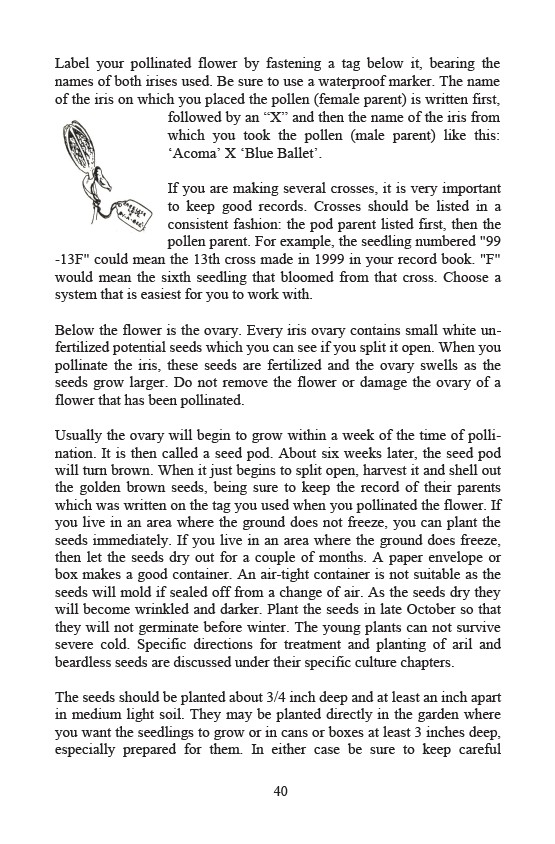
Label your pollinated flower by fastening a tag below it, bearing the
names of both irises used. Be sure to use a waterproof marker. The name
of the iris on which you placed the pollen (female parent) is written first,
followed by an “X” and then the name of the iris from
which you took the pollen (male parent) like this:
„Acoma‟ X „Blue Ballet‟.
If you are making several crosses, it is very important
to keep good records. Crosses should be listed in a
consistent fashion: the pod parent listed first, then the
pollen parent. For example, the seedling numbered "99
-13F" could mean the 13th cross made in 1999 in your record book. "F"
would mean the sixth seedling that bloomed from that cross. Choose a
system that is easiest for you to work with.
Below the flower is the ovary. Every iris ovary contains small white un-fertilized
potential seeds which you can see if you split it open. When you
pollinate the iris, these seeds are fertilized and the ovary swells as the
seeds grow larger. Do not remove the flower or damage the ovary of a
flower that has been pollinated.
Usually the ovary will begin to grow within a week of the time of polli-nation.
It is then called a seed pod. About six weeks later, the seed pod
will turn brown. When it just begins to split open, harvest it and shell out
the golden brown seeds, being sure to keep the record of their parents
which was written on the tag you used when you pollinated the flower. If
you live in an area where the ground does not freeze, you can plant the
seeds immediately. If you live in an area where the ground does freeze,
then let the seeds dry out for a couple of months. A paper envelope or
box makes a good container. An airtight
container is not suitable as the
seeds will mold if sealed off from a change of air. As the seeds dry they
will become wrinkled and darker. Plant the seeds in late October so that
they will not germinate before winter. The young plants can not survive
severe cold. Specific directions for treatment and planting of aril and
beardless seeds are discussed under their specific culture chapters.
The seeds should be planted about 3/4 inch deep and at least an inch apart
in medium light soil. They may be planted directly in the garden where
you want the seedlings to grow or in cans or boxes at least 3 inches deep,
especially prepared for them. In either case be sure to keep careful
40